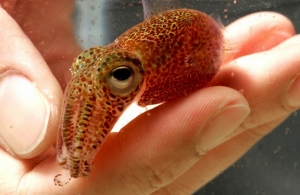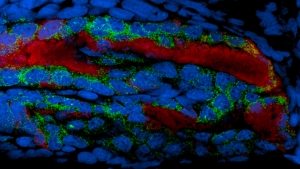Luminescent bacteria that live harmoniously inside the Hawaiian bobtail squid’s light organ actually change the gene expression in other organs of their squid host. That startling finding was revealed in a new study published in Proceedings of the National Academy of Sciences by researchers in the School of Ocean and Earth Science and Technology (SOEST) at the University of Hawaiʻi at Mānoa.


Bacteria have been driving animal biology since the origin of animals, and most animal-bacteria associations benefit the lives of their host organism in a relationship called symbiosis. Understanding the interdependence of microbes and other organisms, including humans, is the frontier of medicine and environmental health.
The Hawaiian bobtail squid is active at night in the shallow waters of the Hawaiian archipelago. It emits from its body the light produced by its bacterial partner to camouflage against moonlight and starlight. The animal modulates the bioluminescence output of its microbes in response to variations in environmental light, such as from cloud cover. This behavior is believed to be controlled through feedback between the eye and light organ.
How far does the microbes’ influence go?
For nearly three decades, the laboratories of director Margaret McFall-Ngai and researcher Edward Ruby at the Pacific Biosciences Research Center (PBRC) in SOEST have used the Hawaiian bobtail squid and its light-producing symbiont, Vibrio fischeri, as a model biological system to unravel the details of this mysterious and vital relationship.
Silvia Moriano-Gutierrez, graduate student in PBRC with McFall-Ngai, asked the question: Does Vibriocolonization of the Hawaiian bobtail squid light organ influence gene expression in other parts of the squid’s body?
“My first surprise was that the most significant driver of gene expression in the light organ is not the presence of the bacteria themselves, but rather the presence of bacteria that make light,” said Moriano-Gutierrez. “In other words, light production by the symbionts was a more significant driver of host gene expression.”
Doing their job of producing bioluminescence
The fact that the gene expression responds more to light production than to bacterial presence underscores the importance to the animal of the bacteria doing their job of producing bioluminescence.
Next, the researchers assessed how the varying conditions affected tissues remote from the symbionts, that is, the eye and gill. Both of these organs responded to these conditions with their own unique gene expression signature. The gills responded similarly to the presence of both wild-type and dark mutants.
“However, the next big surprise was that, while the eye responded with robust changes in the expression of dozens of genes when the light organ is colonized by wild-type, when colonized by the dark mutant, no genes changed their regulation in the eye,” said Ruby. “The data support the idea that coordination between eye and light organ is important for the use of light in the animal’s behavior.”
With future research, the team will address which other possible features of the symbiont trigger such responses in host tissues, and how those signals get to remote tissues, in an effort to understand the mechanism underlying the complexity of host-microbe communication.
For the full story, see the SOEST website.
—By Marcie Grabowski

